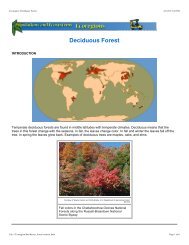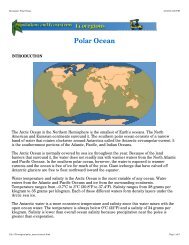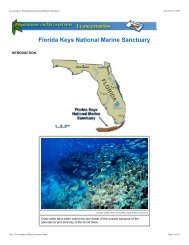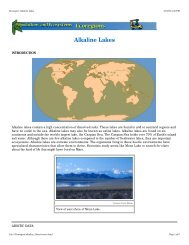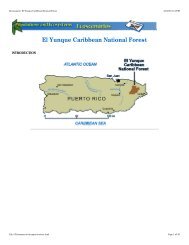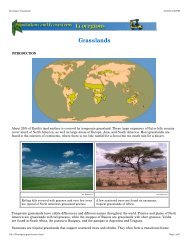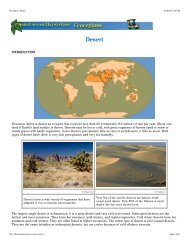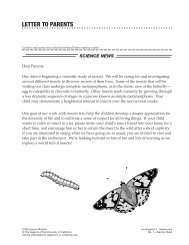Ecoscenarios Combined - FOSSweb
Ecoscenarios Combined - FOSSweb
Ecoscenarios Combined - FOSSweb
You also want an ePaper? Increase the reach of your titles
YUMPU automatically turns print PDFs into web optimized ePapers that Google loves.
Ecoscenario: Mono Lake<br />
4/16/03 3:18 PM<br />
on Earth. Humans have a tremendous thirst for water, and whenever they see an opportunity to gather some up and apply it to human<br />
use and enterprise, they usually do.<br />
The Los Angeles Department of Water and Power looked at the streams running out of the Sierra Nevada into what seemed to be a<br />
salty, useless lake, and contracted to build a system of diversion dams to ship the water south for Angelinos. The project was completed<br />
in 1941, and virtually all the water destined for Mono Lake was piped to southern California. Without the annual inflow of fresh water, the<br />
lake began to dry up. The lake level, standing at 1956.5 meters (6417 feet) in 1941, began a steady decline. The water level dropped 30<br />
centimeters (1 foot) or so each year. Twenty years later the lake stood at 1950 meters (6396 feet), a drop of 6.5 meters (21 feet) since<br />
the onset of diversion.<br />
Courtesy of Mono Lake Committee Courtesy of Mono Lake Committee Courtesy of Mono Lake Committee<br />
Photo taken in 1962 when the water level was<br />
already 7.5 meters (25 feet) below the<br />
original level.<br />
The same tufa towers in a photo taken in<br />
1968.<br />
The tufa towers are completely exposed in<br />
this photo taken in 1995.<br />
By the mid-1970s the lake level was down 12 meters (40 feet). The lake held half the amount of water it had before diversions started.<br />
The effects were starting to show in the ecosystem. The salt was twice as concentrated, and this stressed the populations of primary<br />
consumers, the brine flies and brine shrimp. The shrimp were not growing as large as usual, and their numbers were declining. This<br />
became clear in 1981 when the brine shrimp production was so reduced that the 50,000 breeding California gulls were not able to catch<br />
enough shrimp to feed their offspring, and 25,000 half-grown chicks starved to death. A generation of California gulls was lost.<br />
Furthermore, the water was so low at this time that a land bridge developed, connecting Negit Island to the mainland. This allowed<br />
predators like coyotes to walk to the nesting area, where they ate the gull eggs and chicks and drove the adults away.<br />
In addition to the changes to the lake populations, the lower water level caused other problems. As water evaporated, the lake shrank<br />
exposing a layer of alkaline salts. High winds stir up these salts and create toxic dust storms. These dust storms are a health hazard for<br />
everyone living in the Mono Lake basin.<br />
Courtesy of Teri Dannenberg<br />
A rim of salts appeared as the water level dropped.<br />
Courtesy of Teri Dannenberg<br />
High winds stir up an alkaline dust storm that<br />
decreases visibility.<br />
In 1978 a young man named David Gaines recognized the plight of Mono Lake and founded an action group called the Mono Lake<br />
Committee. He started to work on ways to reverse the damage done by the water diversions. He worked tirelessly with the National<br />
Audubon Society, California Trout, the California Department of Fish and Game, the U.S. Forest Service, and the Los Angeles<br />
Department of Water and Power (LADWP) to find solutions to the problem. Often the issues ended up in court.<br />
In 1984 the first of several lawsuits was decided in favor of Mono Lake. The LADWP was ordered to release 0.57 cubic meters (19 cubic<br />
feet) of water per second into the lake. In 1986 another suit resulted in the release of another 0.3 cubic meter (10 cubic feet) per second.<br />
file:///Ecoscenario/mono/content.html<br />
Page 8 of 11



